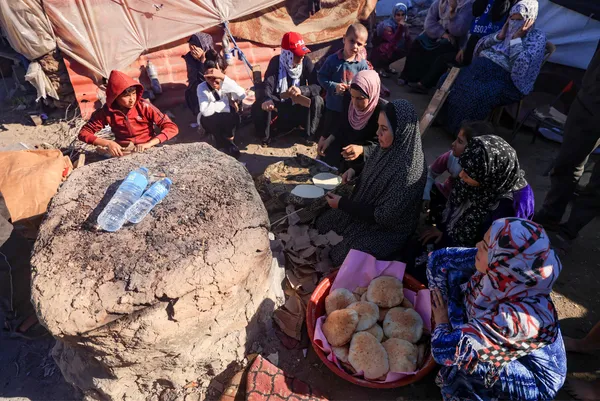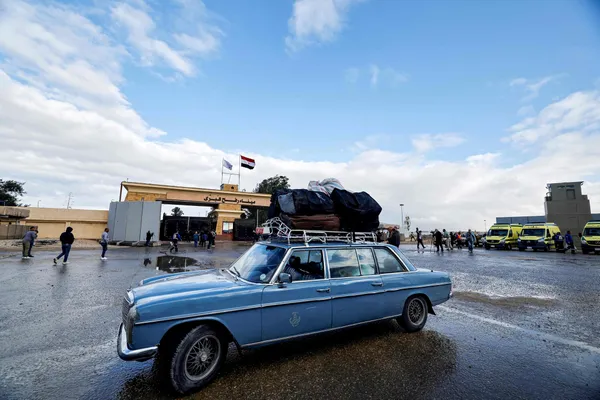Any Israeli – including politicians – supporting a ground offensive in Khan Yunis must remember that after the war the final data will be placed on the desk of every foreign minister and media outlet in the world

As 25 to 44 percent of Israelis support the rebuilding of Jewish settlements in the Gaza Strip – according to polls by the Jewish People Policy Institute and Israel’s “Meet the Press” – the land where the Gaza settlements once lay awaits more displacements of Palestinians.
The Israel Defense Forces’ order to the people of northern Gaza to leave their homes is supposed to be evidence that the army doesn’t intend to harm civilians not involved in the fighting. As has already been stated in leaflets dropped by the air force, anyone who violates this order may be considered a member of a terror group.
From this it follows that residents who choose to remain in their homes in northern Gaza are responsible for their deaths from Israeli missile strikes or exchanges of fire, or for being buried under the rubble. According to the army’s reasoning, if it was right to do this in southern Lebanon, it’s right to do it in Gaza.
But the Palestinian coastal enclave is much smaller than Lebanon – 365 square kilometers (141 square miles) compared with 10,230 square kilometers – and Gaza’s population density is much higher: 6,100 people per square kilometer (according to the Palestinian Central Bureau of Statistics) compared with 547 in Lebanon (according to the World Bank).
Therefore, one cannot stress enough the health and humanitarian effects of packing more than 2 million people into less than half the enclave as fighting goes on nearby, including bombs falling from the air.
Specifically, those who want the ground offensive to continue until “the collapse of Hamas” must be made aware of the effects – including the political ones – when the war ends and the final data is verified and placed on the desk of every foreign minister and media outlet around the world.
In addition to the contagious diseases that have been reported by medical officials – including respiratory infections, gastrointestinal ailments and skin diseases – there were reports last week that hepatitis A is spreading among some of the displaced people. This comes on top of the constant food shortage that particularly affects children and pregnant women, the shortage of medication for people with chronic diseases, and the difficulty in treating the tens of thousands of wounded in an ever-diminishing number of active hospitals – and without anesthetics.
Awareness of the severe conditions and the expected effects if the war continues prompted some very convoluted language from a U.S. official. “We have reinforced this in very clear language with the government of Israel – very important that the conduct of the Israeli campaign when it moves to the south must be done in a way that is to a maximum extent not designed to produce significant further displacement of persons,” the official told reporters in a conference call a week ago, as reported by Reuters.
In other words, resume fighting, but carefully. Does the convoluted language reflect the official’s awareness of his contradiction: the impossibility of sending soldiers and tanks
– accompanied by airstrikes – into densely populated areas while avoiding a mass displacement?

Nowhere to go
As expected, once the fighting resumed Friday, Israel started preparing for the ground offensive in the south, particularly in Khan Yunis, the city and refugee camp where Hamas leader in Gaza Yahya Sinwar was born and raised.
Indeed, contrary to the American official’s statement, Israel has been ordering a significant number of people – the residents and displaced people in the villages east of Khan Yunis and in some of the city’s neighborhoods – to go south. Every day more neighborhoods are ordered to be evacuated, or the bombings and shelling “convince” those who remained to leave. But where will they go?
During last week’s truce, the IDF didn’t allow people to return to their homes in the north, even to retrieve medication and warm clothing. The assumption is that Israel will continue to prohibit the return of displaced people to northern Gaza, even once the fighting there ends, and so their destination remains the south.
The area south of the Gaza River, made up of three districts, covers 230 square kilometers. About a quarter of this is agricultural land that theoretically could accommodate more displaced people. But the IDF has established a 1-kilometer-long strip along Gaza’s eastern border – at least 30 square kilometers – that Gazans may not approach.
Already before the one-week truce, the IDF instructed the residents of five of the villages east of Khan Yunis to leave, and after the truce it reiterated its order to evacuate. So, by a conservative estimate, we can say that of the 230 square kilometers in southern Gaza, we should subtract at least 60 square kilometers where the IDF bans the presence of Palestinian residents.
Khan Yunis and its refugee camp cover about 54 square kilometers. Even assuming that some people would prefer to risk staying in their homes – as an unknown but significant number of residents of Gaza City and the Jabalya refugee camp have done – this urban area must also be subtracted from the “safe” space in the south.
Before the war, the south’s three districts – Deir al-Balah, Khan Yunis and Rafah – held about 1 million people (out of about 2.2 million in all Gaza), with a density of 4,347 people per square kilometer. During the truce and after the displacement from eastern and northern Gaza, the population density could be estimated at about 11,000 people per square kilometer.
Now, the evacuation orders from the Khan Yunis region, and the expected ground invasion into this area – alongside or following bombardment from the air, sea and land – imply an intention to crowd around 2 million people into 110 square kilometers – 18,181 people per square kilometer. The water and power grids, the roads and the health care system – which even in quiet times fell short of the needs of around 1 million people and are hardly functioning now – will collapse under the strain of around 2 million people.
The agricultural land, which is still yielding produce, will fill with tents and possibly prefab homes brought in as humanitarian aid through the Rafah crossing, as one rumor suggests. Gaza’s factories are largely in the north, and if they haven’t been destroyed, they’re out of operation. At best, the hospitals and clinics still functioning in Khan Yunis will be inaccessible, and at worst they will be severely damaged, as has happened in the north.
The proximity of every “safe” area to a combat zone means that any targeted shelling and bombing, or any accidental deviation from a target, will cause many civilian casualties. Logic says that as the population density increases, so will the number of victims.

To the beach
A sparsely inhabited agricultural area in Gaza stretches from Rafah in the south to Deir al-Balah halfway up the Strip. Depending on how you calculate its width, this area ranges from 14 to 26 square kilometers. On October 18, the IDF’s Arabic-language spokesman, Avichay Adraee, mentioned this strip when he posted his daily order on Facebook to the residents of Gaza City, ordering them to evacuate part of it.
Until they were dismantled in 2005, 16 of Israel’s 22 settlements in Gaza were on the southwest coast west of Khan Yunis. Around 6,500 Israelis lived there out of the 9,000 settlers in all of Gaza, along with a few hundred Palestinian farmers. Until the war resumed Friday, 300,000 displaced people joined the original 291,000 inhabitants of Khan Yunis city and refugee camp. Soon they will all be ordered to evacuate.
How many of them can be concentrated and condensed in the area of these former settlements where residential neighborhoods, university branches and military training bases have gone up since 2005?
Several thousand people were displaced to this area in the first month of the war. How many more will be forced to cram into it – into their relatives’ apartments, tent camps and maybe even prefab homes – without suitable urban infrastructure as Khan Yunis’ hospitals gradually shut down?
“You’re asking me to describe something that’s indescribable,” says Omar Shaaban, an economist and Deir al-Balah resident who was outside Gaza when the war began. “People who haven’t found shelter with relatives, or in schools or hospitals, are sleeping in their cars. I have several friends who are sleeping with their families in cars. In a couple of weeks, would New York be able to take in an amount of people that doubles its population?”
If not in IDF attacks and exchanges of fire, Gazans may die of diseases and epidemics caused by overcrowding and a lack of water and medical care, especially during winter’s cold and rain. Their absolute dependence on humanitarian aid is among the reasons for widespread depression and fatigue in Gaza. Talk of emigration is increasing, along with rumors about bribes to enter Egypt.
An engineer who lived and worked in the Strip around 20 years ago predicts that the unbearable overcrowding amid the attacks and fighting will compel desperate Gazans to break through the border fence with Egypt.
With this in mind, he wonders whether, despite Egypt’s declarations opposing Israel’s plan to settle Gazans on its territory, Egyptian President Abdel-Fattah al-Sissi will dare order his police to shoot and kill many thousands of desperate, thirsty, hungry and frightened people trying to save their lives and their children’s lives.
